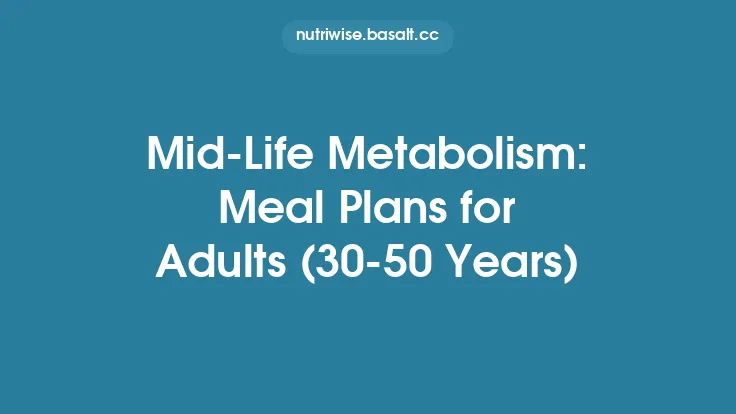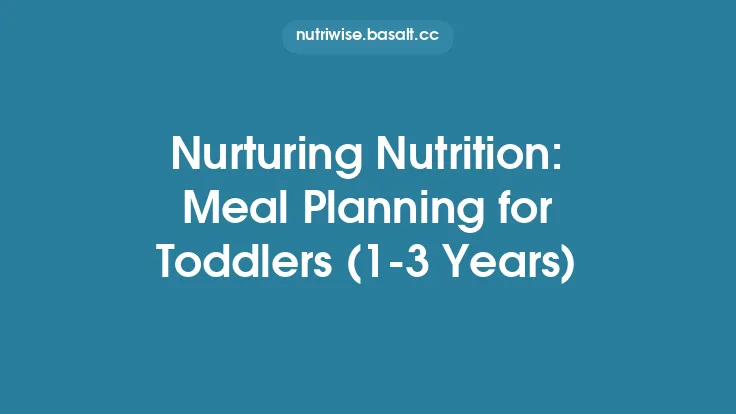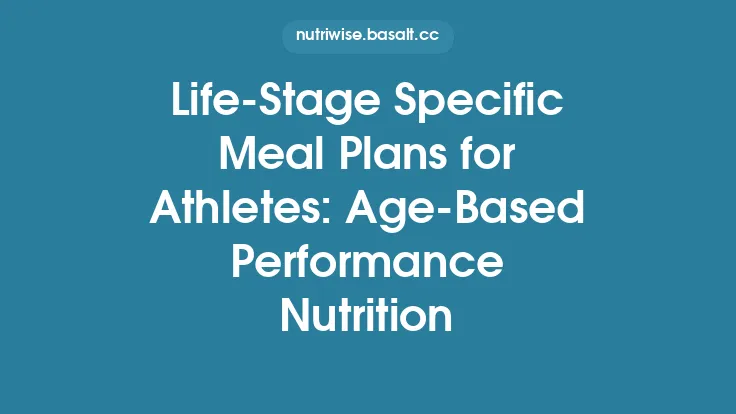Adolescence is a period of rapid physical growth, hormonal change, and evolving lifestyle habits. During these years, the body’s demand for calories, protein, vitamins, and minerals spikes, yet many teens struggle to meet those needs because of busy school schedules, social influences, and a growing desire for independence in food choices. Crafting balanced meal plans that respect a teen’s developing palate while delivering the nutrients essential for growth, brain development, and overall health is both an art and a science. Below is a comprehensive guide that breaks down the nutritional foundations, practical planning strategies, and adaptable templates to help teens (13‑19 years) fuel their bodies and minds every day.
Understanding the Nutritional Demands of Adolescence
| Growth Aspect | Primary Nutrient Needs | Why It Matters |
|---|---|---|
| Linear growth (height) | Calcium, Vitamin D, Protein, Zinc | Supports bone elongation and muscle development |
| Brain maturation | Omega‑3 fatty acids, Iron, B‑vitamins | Enhances cognition, memory, and mood regulation |
| Hormonal changes (e.g., menarche) | Iron, Folate, Magnesium | Replaces menstrual losses and stabilizes energy |
| Increased physical activity (sports, clubs) | Carbohydrates, Electrolytes, Vitamin C | Supplies quick energy and aids recovery |
During early adolescence (13‑15 years) growth velocity is highest, while late adolescence (16‑19 years) sees a shift toward body composition changes and preparation for adult metabolic patterns. Meal plans should therefore be flexible enough to accommodate these shifting priorities.
Macronutrient Balance for Growing Teens
| Macronutrient | Recommended % of Total Daily Calories* | Practical Food Sources |
|---|---|---|
| Carbohydrates | 45‑60 % | Whole grains (brown rice, quinoa), legumes, fruits, starchy vegetables |
| Protein | 15‑20 % (≈ 0.85‑1.0 g/kg body weight) | Lean meats, poultry, fish, eggs, dairy, tofu, tempeh, beans |
| Fat | 25‑35 % (focus on unsaturated) | Avocado, nuts, seeds, olive oil, fatty fish (salmon, sardines) |
\*Percentages are based on a typical 2,200‑2,800 kcal/day range for most adolescents; individual needs may vary with activity level, sex, and body size.
Carbohydrate quality matters. Prioritize complex carbs with fiber (e.g., whole‑grain breads, oats) over refined sugars to sustain blood glucose and support gut health.
Protein timing can aid muscle repair. Including a source of protein in each main meal and a modest amount in snacks helps maintain a positive nitrogen balance, especially for active teens.
Healthy fats are essential for hormone production. Omega‑3s (EPA/DHA) from fish or algae supplements are particularly beneficial for brain health and inflammation control.
Key Micronutrients and Their Food Sources
| Micronutrient | Daily Recommended Intake (ages 13‑18) | Food Sources |
|---|---|---|
| Calcium | 1,300 mg | Dairy (milk, yogurt, cheese), fortified plant milks, leafy greens (kale, bok choy) |
| Vitamin D | 600 IU (15 µg) | Sun exposure, fortified milk, fatty fish, egg yolk |
| Iron | 11 mg (boys) / 15 mg (girls) | Red meat, poultry, lentils, fortified cereals, spinach |
| Zinc | 8 mg (girls) / 11 mg (boys) | Beef, pumpkin seeds, chickpeas, dairy |
| Folate | 400 µg | Dark leafy greens, legumes, citrus fruits |
| Magnesium | 360 mg (boys) / 310 mg (girls) | Nuts, whole grains, bananas, dark chocolate |
| Vitamin C | 75 mg (boys) / 65 mg (girls) | Citrus, strawberries, bell peppers, broccoli |
| Vitamin A (β‑carotene) | 900 µg RAE (boys) / 700 µg RAE (girls) | Sweet potatoes, carrots, apricots, fortified cereals |
Iron absorption tip: Pair iron‑rich plant foods with vitamin C sources (e.g., lentil soup with tomato salsa) to boost non‑heme iron uptake.
Calcium & Vitamin D synergy: Adequate vitamin D improves calcium absorption; encourage a daily serving of fortified dairy or a plant‑based alternative plus safe sun exposure.
Structuring a Daily Meal Pattern
- Breakfast (20‑25 % of daily calories)
- Aim for a mix of complex carbs, protein, and fruit.
- Example: Greek yogurt parfait with granola, berries, and a drizzle of honey.
- Mid‑Morning Snack (5‑10 %)
- Light, protein‑rich snack to curb hunger before school.
- Example: Apple slices with almond butter.
- Lunch (30‑35 %)
- Balanced plate: ½ vegetables/fruits, ¼ lean protein, ¼ whole grains.
- Example: Whole‑grain wrap with grilled chicken, mixed greens, avocado, and a side of carrot sticks.
- Afternoon Snack (5‑10 %)
- Focus on sustained energy for after‑school activities.
- Example: Hummus with whole‑grain pita chips.
- Dinner (25‑30 %)
- Similar plate composition to lunch, with emphasis on nutrient‑dense vegetables.
- Example: Baked salmon, quinoa pilaf, roasted broccoli, and a small mixed fruit salad.
- Optional Evening Snack (if needed)
- Keep it modest and protein‑focused to support overnight recovery.
- Example: Cottage cheese with pineapple chunks.
Timing note: Encourage a 3‑ to 4‑hour interval between meals and snacks to maintain stable blood glucose and prevent overeating later in the day.
Sample One‑Week Meal Plan (2,400 kcal/day)
| Day | Breakfast | Lunch | Dinner | Snacks |
|---|---|---|---|---|
| Mon | Oatmeal cooked in milk, topped with sliced banana & walnuts | Turkey & cheese whole‑grain sandwich, side salad, orange | Stir‑fried tofu, brown rice, mixed veggies, soy‑ginger sauce | Greek yogurt; carrot sticks with hummus |
| Tue | Scrambled eggs, whole‑grain toast, avocado, kiwi | Lentil soup, whole‑grain roll, cucumber‑tomato salad | Grilled chicken breast, sweet potato mash, steamed green beans | Apple with peanut butter; low‑fat cheese stick |
| Wed | Smoothie (spinach, frozen berries, Greek yogurt, chia seeds) | Sushi bowl (brown rice, salmon, avocado, edamame, pickled ginger) | Beef chili with black beans, cornbread, side of coleslaw | Trail mix (almonds, dried cranberries, dark chocolate); orange |
| Thu | Whole‑grain pancakes, maple syrup, side of Greek yogurt | Chickpea salad wrap, carrot sticks, grapes | Baked cod, quinoa pilaf, roasted Brussels sprouts | Banana; cottage cheese with sliced peaches |
| Fri | Breakfast burrito (egg, black beans, salsa, whole‑grain tortilla) | Grilled veggie and hummus panini, side of mixed fruit | Turkey meatballs, whole‑wheat spaghetti, marinara, side salad | Yogurt parfait; whole‑grain crackers with cheese |
| Sat | Bagel with cream cheese, smoked salmon, cucumber slices | DIY taco night: lean ground turkey, whole‑grain tortillas, lettuce, tomato, guacamole | Homemade pizza on whole‑grain crust, topped with mozzarella, veggies, chicken | Fresh berries; protein bar (low sugar) |
| Sun | French toast (whole‑grain bread), berries, a dollop of ricotta | Quinoa salad with roasted vegetables, feta, lemon‑olive oil dressing | Roast chicken, mashed cauliflower, sautéed kale | Smoothie bowl; popcorn (lightly salted) |
*Adjust portion sizes based on individual caloric needs and activity level.*
Snack Strategies for Energy and Focus
- Combine protein and fiber: A handful of nuts with an apple, or a slice of whole‑grain toast topped with cottage cheese, stabilizes blood sugar and sustains concentration during study sessions.
- Portable options: Pre‑portion trail mix, roasted chickpeas, or cheese sticks in reusable containers for easy grab‑and‑go.
- Mindful indulgence: Allow occasional treats (e.g., a small piece of dark chocolate) to satisfy cravings without derailing overall balance.
Hydration and Beverage Choices
- Water first: Aim for 1.5‑2 L per day, more if physically active or in hot climates. Encourage a reusable bottle to track intake.
- Milk or fortified plant milks: Provide calcium, vitamin D, and protein; 1‑2 servings daily are beneficial.
- Limit sugary drinks: Sodas, energy drinks, and excessive fruit juices can displace nutrient‑dense foods and contribute to excess calories.
- Caffeine caution: If teens consume coffee or tea, keep it under 100 mg per day (≈ 1 cup) and avoid late‑day consumption to protect sleep quality.
Adapting Plans for Activity Levels and Sports
| Activity Level | Additional Caloric Needs | Adjustments |
|---|---|---|
| Low (mostly sedentary) | +0‑200 kcal | Maintain baseline plan; focus on nutrient density |
| Moderate (school sports, 3‑5 hrs/week) | +200‑400 kcal | Add a carbohydrate‑rich snack post‑practice (e.g., banana + yogurt) |
| High (intensive training, >5 hrs/week) | +400‑600 kcal | Increase complex carbs at dinner and include a recovery shake (protein + carbs) after workouts |
Pre‑exercise fueling: 30‑60 minutes before activity, a small snack with 15‑30 g carbs (e.g., a granola bar) can improve performance.
Post‑exercise recovery: Within 30 minutes, combine 20‑30 g protein with 0.5‑0.7 g/kg body weight of carbs (e.g., chocolate milk, turkey sandwich) to replenish glycogen and support muscle repair.
Addressing Common Challenges
- Picky Eating
- Rotate foods: Offer the same nutrient groups in different preparations (e.g., raw carrots, roasted carrots, carrot soup).
- Involve teens in cooking: Hands‑on tasks increase willingness to try new dishes.
- Time Constraints
- Batch cooking: Prepare grains, beans, and roasted vegetables on weekends for quick assembly during the week.
- One‑pot meals: Chili, stir‑fries, and sheet‑pan dinners reduce prep and cleanup.
- Body Image Concerns
- Emphasize performance and health over weight.
- Encourage regular, balanced meals rather than restrictive dieting.
- Provide resources on media literacy and positive self‑talk.
- Budget Limitations
- Choose cost‑effective protein sources (e.g., eggs, canned fish, legumes).
- Buy seasonal produce and frozen fruits/vegetables, which retain nutrients and are often cheaper.
Practical Tips for Families and Caregivers
- Create a visual meal calendar that lists breakfast, lunch, dinner, and snack options for the week. Involve the teen in selecting favorite meals.
- Stock a “smart pantry.” Keep whole‑grain pasta, brown rice, canned beans, low‑sodium broth, nuts, and frozen vegetables on hand for quick, nutritious meals.
- Teach label reading. Show how to compare added sugars, sodium, and fiber content to make informed choices.
- Model balanced eating. When parents and siblings eat varied, nutrient‑dense foods, teens are more likely to follow suit.
- Use technology wisely. Apps that track food intake can help teens become aware of portion sizes, but encourage them to view data as a guide, not a strict rule.
Monitoring Progress and Adjusting the Plan
- Regular check‑ins (every 4‑6 weeks). Review energy levels, academic performance, mood, and any changes in weight or body composition.
- Growth charts and BMI percentiles (used judiciously) can indicate whether caloric intake aligns with growth trajectories.
- Feedback loop: Ask the teen what foods they enjoy, what feels satiating, and where they experience cravings. Adjust recipes accordingly.
- Professional input: If there are concerns about nutrient deficiencies, eating disorders, or chronic health conditions, consult a registered dietitian or pediatrician.
Bottom Line
Balanced meal planning for adolescents is a dynamic process that blends scientific nutrition principles with the realities of teenage life. By focusing on whole foods, ensuring adequate macro‑ and micronutrient distribution, and building flexible, enjoyable routines, teens can meet the heightened demands of growth, brain development, and physical activity. Empowered with knowledge and practical tools, they—and the adults who support them—can create sustainable eating habits that lay the foundation for lifelong health.





